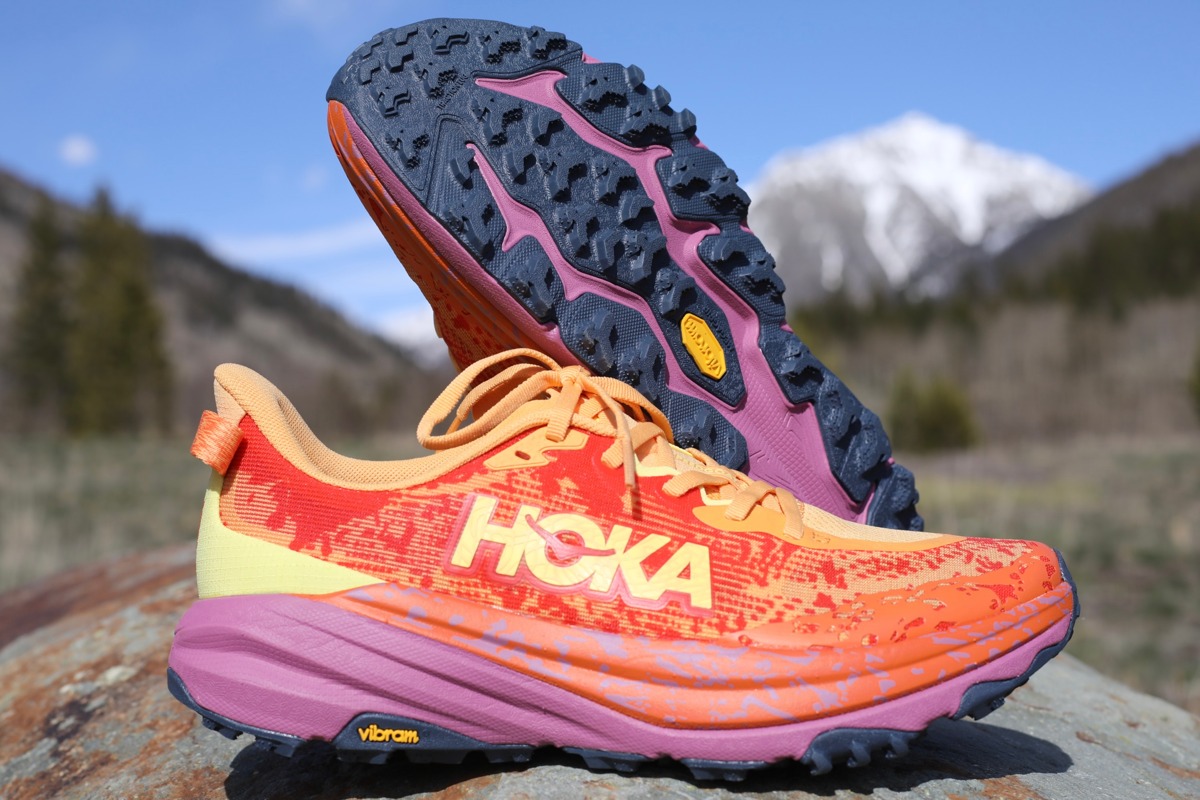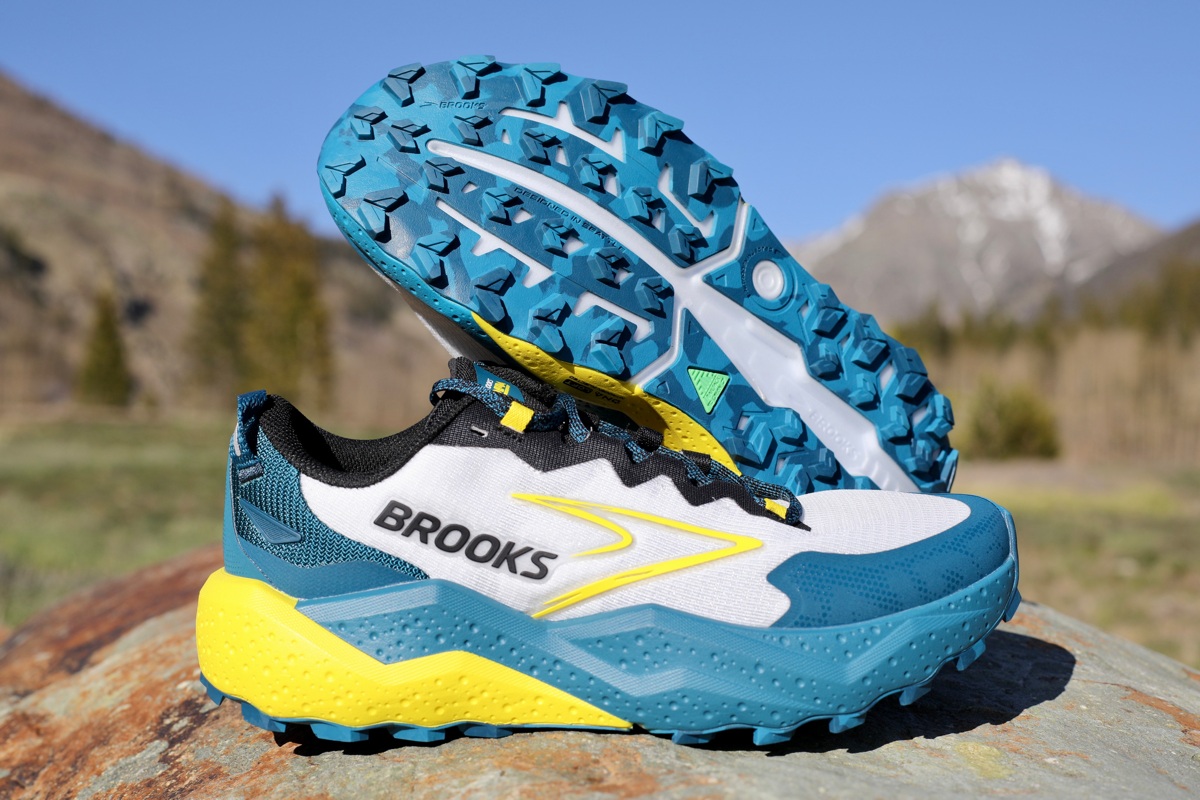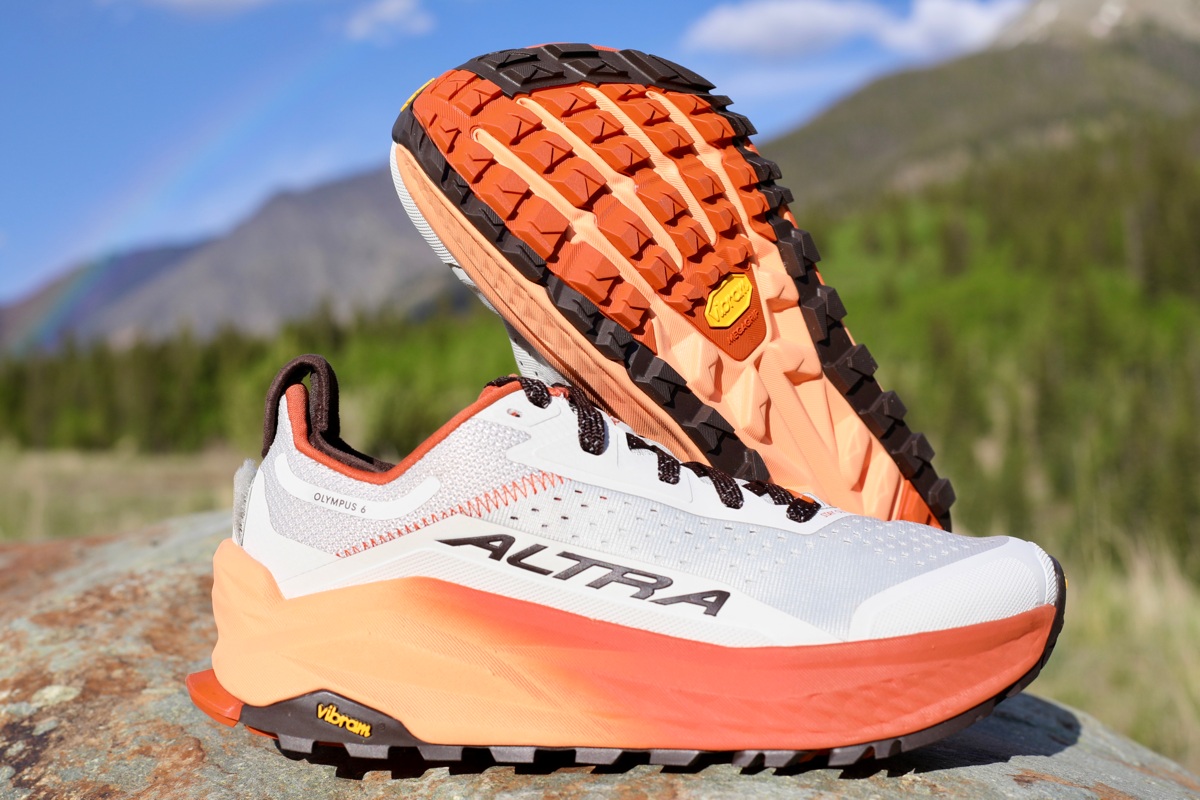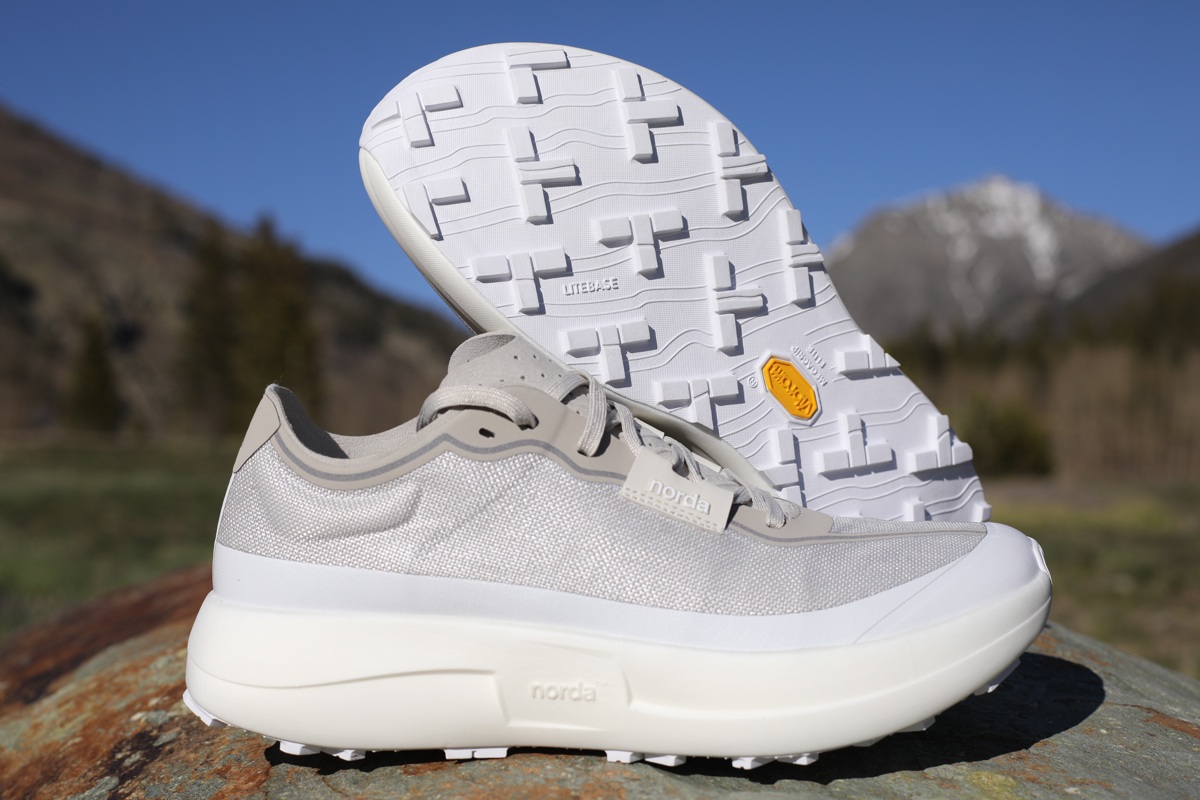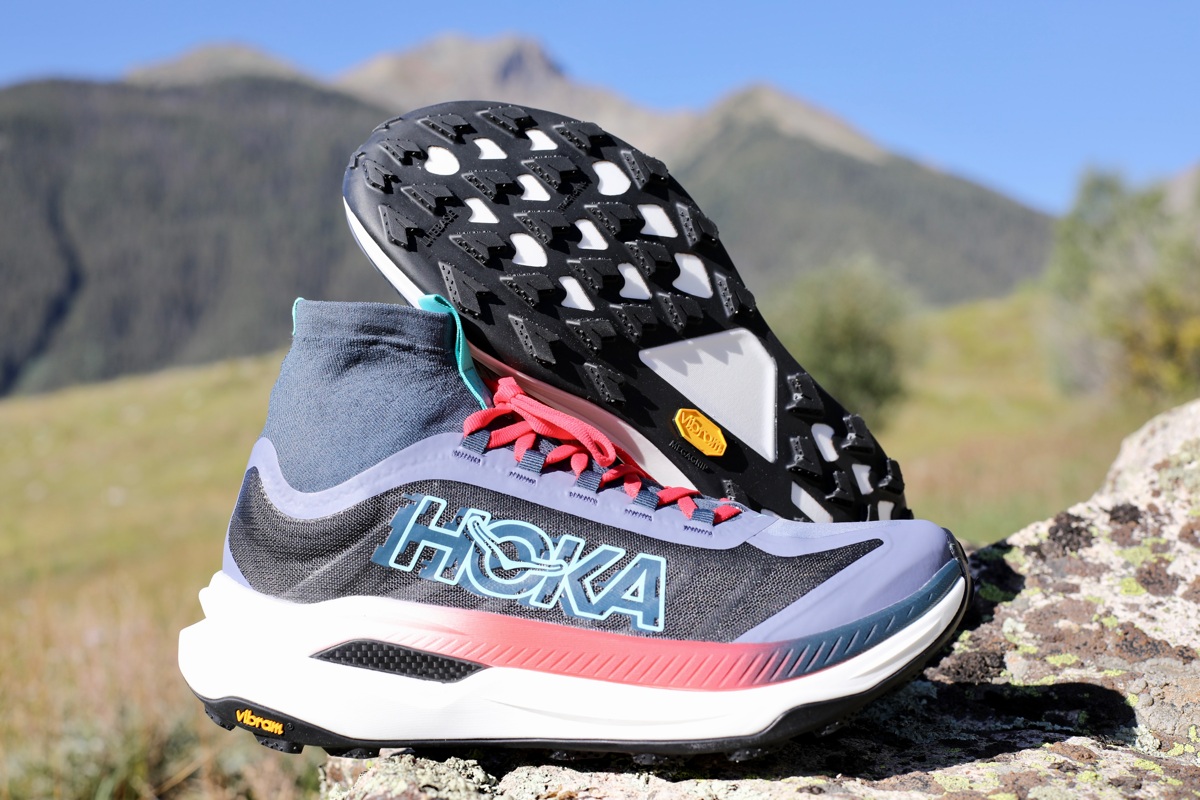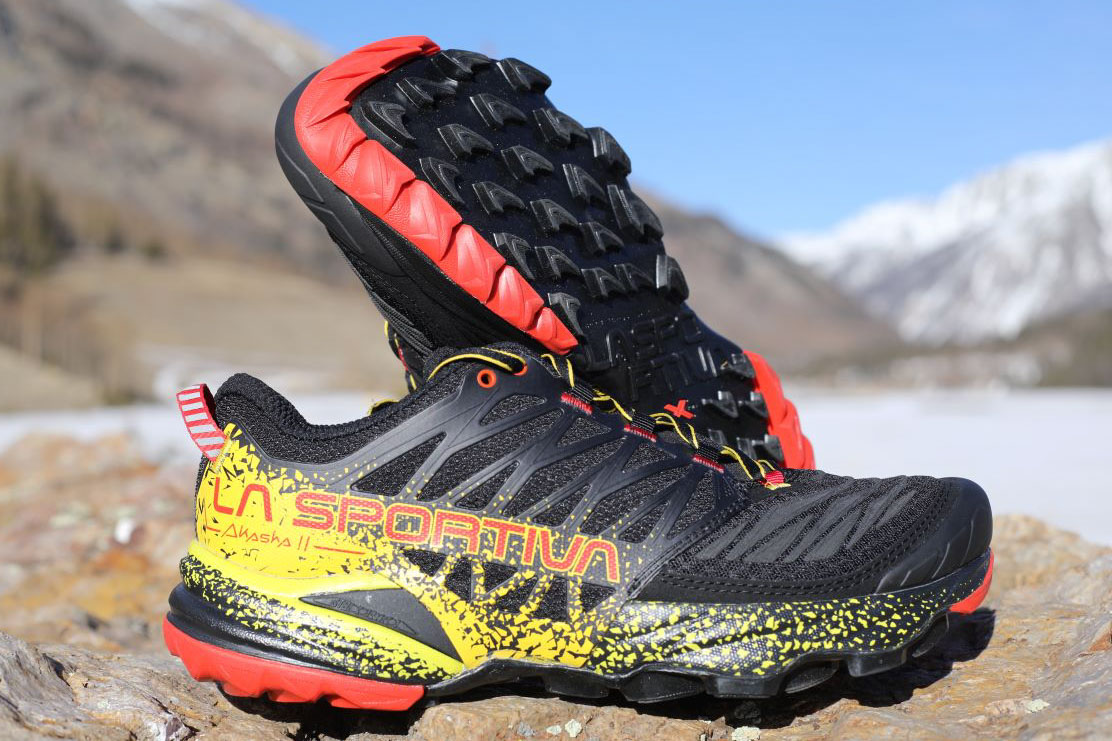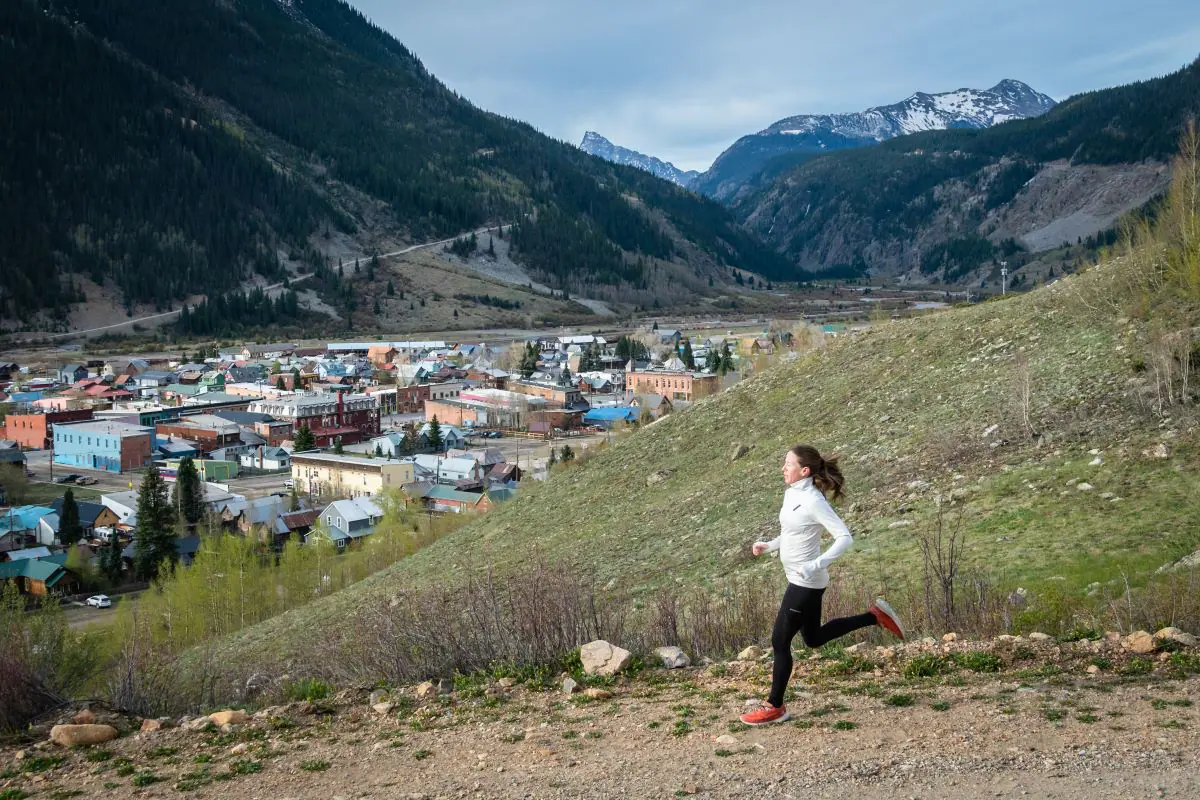
Alli Miles tests the cushy Hoka Tecton X 2 on desert trails. Photo: iRunFar/Eszter Horanyi
Whatever your motivation for finding the best cushioned trail running shoes, be it aiding in injury prevention and recovery, reducing fatigue in your legs from day to day activities, or because you mainly run hard-packed, non-technical trails, the choices right now are plentiful and much more varied than in the past. While Hoka kickstarted maximal cushioning, nearly every brand that offers trail shoes provides at least a moderately cushioned model, with the trend being toward increased cushioning across entire product lineups.
Many elements we love in a modern highly cushioned shoe, like the plush ride, finally include features that older options typically lacked, such as lightness, ground feel, and stability. We no longer have to choose cushion over all else.
For this guide, we rounded up and tested the best moderately and maximally cushioned trail running shoes. To learn more about finding the right cushioned trail running shoe for you, scroll down to our recommendations for how to choose, as well as our frequently asked questions. Finally, learn more about our research and testing methodology.
Check out our Best Trail Running Shoes guide for more great options, including more generalist trail shoes.
Best Cushioned Trail Running Shoes
- Best Cushioned Trail Shoe: Hoka Speedgoat 6
- Next Best Maximally Cushioned Trail Running Shoe: Brooks Caldera 8
- Best Moderately Cushioned Trail Running Shoe: Nike Pegasus Trail 5
- Best Zero-Drop Maximally Cushioned Trail Shoe: Altra Olympus 6
- Best Cushioned Trail Shoe for Recovery Runs: Norda 005
Additional Outstanding Cushioned Trail Running Shoes
- Hoka Tecton X 3 (maximal cushion)
- La Sportiva Akasha II (moderate cushion)
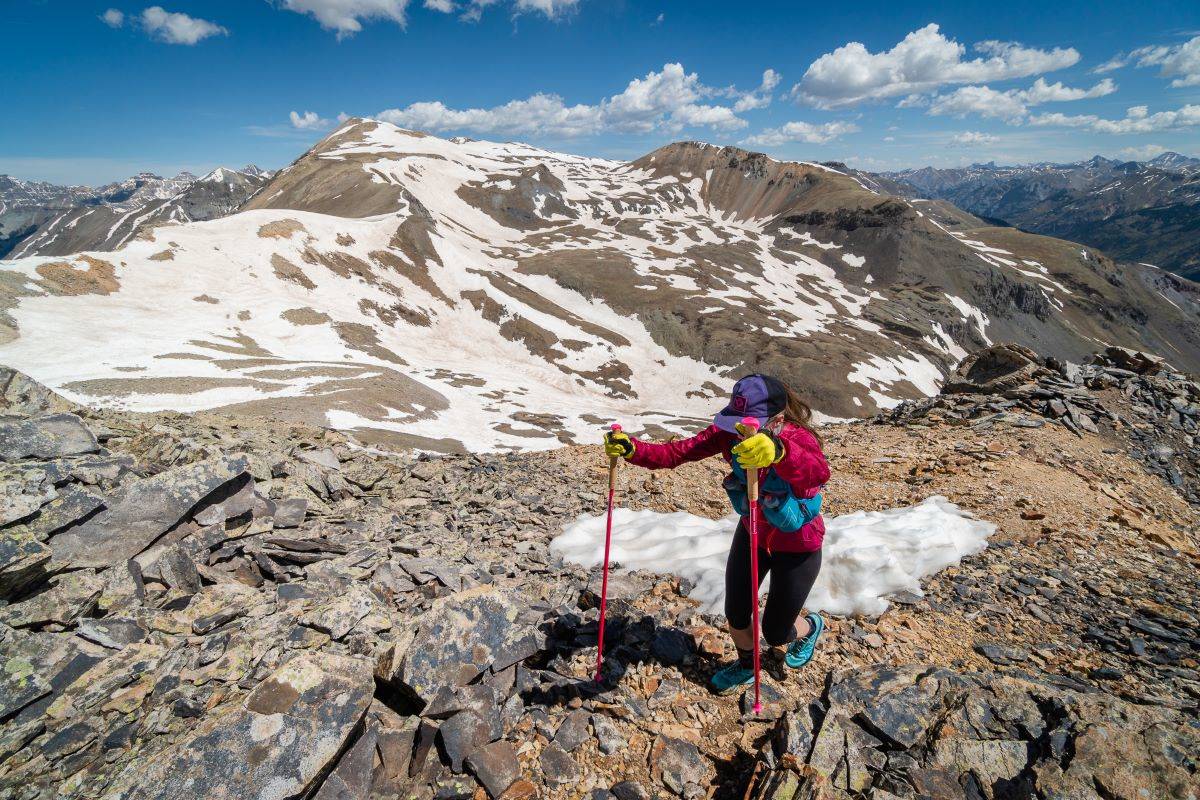
Testing the moderately cushioned Scarpa Spin Infinity on technical terrain in Colorado. Photo: iRunFar/Eszter Horanyi
Best Cushioned Trail Running Shoe: Hoka Speedgoat 6 ($155)
Actual Weight (U.S. men’s 9): 9.9 oz (280 g) | Stack Height: 40/35 mm heel/toe for men’s, 38/33 for women’s | Drop: 5 mm
Pros:
- A return to more structured upper improves foot lockdown for better control on technical terrain
- Firmer midsole feels springier on paved sections
Cons:
- The shoe is not for narrow-footed runners
- The firmer midsole is less forgiving on very long outings
Where the Hoka Speedgoat 5 felt like a huge, multi-faceted revision, the Hoka Speedgoat 6 dials back at least one change that was maligned with the 5. Specifically, the Speedgoat 6 adds more internal structure in the upper, making it much more capable and confidence-inspiring on technical terrain.
The outsole is made of the same Vibram Megagrip material and has a very similar lug pattern to the previous version. The Speedgoat, throughout the years, has been a high performer in many different conditions, but the Speedgoat 6 continues with its lugs-on-lugs feature, which adds surface area for additional traction. One tester called it “one of the best outsoles I’ve ever used.”
While some thought the Speedgoat 5 felt softer underfoot than the 4, the Speedgoat 6 swings the pendulum a bit back to the firmer side. That’s great if you want a bit more spring when running on stretches of pavement, but also makes the shoe a bit less forgiving over longer distances. The shoe retains a single-density midsole foam without bells and whistles — no rocker, cage, or anything else to change your gait or pronation. It just feels like a good, well-cushioned midsole with plenty of protection while going slow or fast.
iRunFar gear tester Travis Liles, who has reviewed all versions of the Speedgoat, remarks, “The Speedgoat 6 has good lockdown and a midsole that encourages moving fast.” This shoe definitely works better on wider feet and may be challenging to cinch down around a narrow foot.
The Speedgoat 6 has a 5-millimeter drop from heel to toe and weighs just under 10 ounces, so longtime fans of the Hoka Speedgoat lineage will find that the shoe’s heritage aspects remain present. The Hoka Speedgoat 6’s midsole provides plenty of cushion for nearly any run, and the outsole has loads of traction for almost all conditions.
Read our full Hoka Speedgoat 6 review.
Shop the Men's Hoka Speedgoat 6Shop the Women's Hoka Speedgoat 6
Next Best Maximally Cushioned Trail Running Shoe: Brooks Caldera 8 ($150)
Actual Weight (U.S. men’s 9): 10.9 oz (309 g) | Stack Height: 39/33 mm heel/toe | Drop: 6 mm
Pros:
- A blend of plush cushioning, sturdy construction, and dependable traction
Cons:
- Toebox can be a bit shallow for really long runs
With minimal changes from the previous edition, the Brooks Caldera 8 continues to offer lots of cushioning, and our testers confirm that it’s capable of delivering more than just a super soft ride. Initially, the shoe’s huge surface area can make it feel clunky and its wearer feel uncoordinated on technical terrain, but after some miles, our testers adapted to the feel. These shoes do have an aggressive forefoot rocker, but, again, we quickly got used to that feel, too.
The outsole is a surprise outstanding feature, providing excellent traction in mud, on wet and dry rocks, and on rocks covered in a thin layer of sand or dirt. The performance in mud depends on the consistency: wet, clumpy mud sheds much faster than drier mud. With all the outsole surface area, you will feel any unshed mud as unwelcome additional baggage.
Of course, the standout feature of the Caldera 8 is its super-thick, ultra-plush DNA LOFT v3 cushioning. This midsole offers a smooth ride that absorbs impact and provides lasting comfort. One tester was impressed with how stable the shoe felt, likely due to the very wide base. However, they didn’t find the shoe to be overly responsive.
We’ve heard plenty of folks for whose feet the Hoka Speedgoat don’t quite work who have found happiness in the Caldera.
Read our full Brooks Caldera 8 review.
Shop the Men's Brooks Caldera 8Shop the Women's Brooks Caldera 8
Best Moderately Cushioned Trail Running Shoe: Nike Pegasus Trail 5 ($155)
Actual Weight (U.S. men’s 9): 10.2 oz (290 g) | Stack Height: 37/28 mm heel/toe | Drop: 9.5 mm for U.S. men’s 10 and 8.5 mm for U.S. women’s 8
Pros:
- A dialed-in upper
- Responsive midsole foam
Cons:
- Not one’s first choice for loose scree, talus, or other highly technical terrain, although improved from the Peg Trail 4
The Nike Pegasus Trail 5 is an excellent option for those doing long days on the trails or running on a mix of roads and trails. The Pegasus Trail’s strengths come from the ridiculously great React midsole foam, which one tester of a previous version with the same foam said “felt alive.” Indeed, the Peg Trail 5 feels even plusher underfoot than its predecessor, and it’s that feel that earns this shoe’s spot on this list.
The Pegasus Trail 5 won’t be your top choice in sloppy trails or if you’re looking for a fast and light option for shorter trail races — although it’s improved in both these areas — but it’s an excellent choice for almost everything else. In fact, one tester noted the earlier Pegasus Trail 3 would be “the one shoe I’d take on vacation if I don’t know the conditions I’ll be running in,” and that holds just as true with today’s Pegasus Trail, if not more so. As such, it’s the top choice in our Best Road-to-Trail Shoes guide.
Still, you might want to skip the Pegasus Trail on the rockiest and burliest of runs. It’s simply not designed to be the most protective of shoes, and better options exist for such outings.
The most notable upgrades to the Pegasus Trail 5 are better traction on fine debris, thanks to a redesigned outsole, and a more comfortable ankle collar, especially around the Achilles notch.
You can read our full Nike Pegasus Trail 5 review.
Shop the Men's Nike Pegasus Trail 5Shop the Women's Nike Pegasus Trail 5
Best Zero-Drop Maximally Cushioned Trail Running Shoe: Altra Olympus 6 ($175)
Actual Weight (U.S. men’s 9): 12.5 oz (354 g) | Stack Height: 33/33 mm heel/toe | Drop: Zero
Pros:
- Plushness to rival the best memory foam mattress
Cons:
- Perhaps the heaviest shoe in all of iRunFar’s running shoe buyer’s guides
The Altra Olympus 6 is an enigma. It’s a tank of a shoe that floats on maximal cushioning. Perhaps, we can think of it as an armored hovercraft. This is the sort of shoe you throw on when you want the plushest ride available, speed and precision be damned. Just roll over whatever’s in your path.
While more than capable on moderately technical terrain, the modest lugging limits — perhaps wisely — the 33-millimeter stack height from tackling the burliest or most challenging of terrain.
It’s telling that the Olympus 6 made a convert out of our speed-seeking, carbon-plate-loving tester Craig Randall, who wrote, “This shoe is a massive detour in my rotation, but one I’ve come to really enjoy, particularly on long and rambling mountain runs.” He continued, “This is a max cushioned, max comfort, and max mileage shoe for trail runners and hikers.”
Read our full Altra Olympus 6 review.
Shop the Men's Altra Olympus 6Shop the Women's Altra Olympus 6
Best Cushioned Trail Shoe for Recovery Runs: Norda 005 ($325)
Actual Weight (U.S. men’s 9.5): 8.1 oz (230 g) | Stack Height: 28.5/21.5 mm heel/toe | Drop: 7 mm
Pros:
- Incredibly comfortable
- Lightweight
Cons:
- Expensive
- Not suitable for technical terrain
When iRunFar’s founder Bryon Powell heads out for an easy recovery run — be it on trails or dirt roads — he finds himself grabbing the Norda 005. Why? Because they’re darn comfortable and their light weight makes recovery runs feel even easier. Between the shoe’s squish and minimally structured upper, it’s not suitable for more technical terrain or even faster running on moderate terrain. With that in mind, you probably want to stick to easier runs in the 005.
But how can one justify such an expensive shoe for mostly recovery runs? Well, with the premium materials used in the Norda 005’s upper and midsole, this shoe is going to last you for years, and all that much longer if you’re not destroying them on your hardest or most technical runs. If you buy these shoes, consider it an investment in a long-term relationship. We’ve also named the Norda 005 the most comfortable lightweight trail shoes in our Best Lightweight Trail Shoes guide.
Note that you’ll want to go a half size up in the Norda 005, hence us using a men’s U.S. 9.5 for our reference weight.
Read or watch our full Norda 005 review.
Shop the Men's Norda 005Shop the Women's Norda 005
Additional Outstanding Cushioned Trail Running Shoes
Other Great Maximal Cushioned Trail Shoes: Hoka Tecton X 3 ($275)
Actual Weight (U.S. men’s 9): 9.3 oz (265 g) | Stack Height: 40/35 mm heel/toe for men’s, 39/34 for women’s | Drop: 5 mm
Pros:
- Possibly the most comfortable ride of Hoka’s trail shoes, and that’s saying a lot!
Cons:
- The integrated gaiter is highly divisive
- Big money
Two things that most trail runners could agree with: the Hoka Tecton X 3 are incredibly comfortable underfoot, and they’re quite expensive. Whether they offer a good enough value for the cost is up to you.
In discussing the Tecton X 3, iRunFar’s Editor-in-Chief said, “It’s probably the most comfortable ride of all the brand’s trail shoes. There’s really no comfort comparator to PEBA foam these days. The squish reception of the midsole plus the combined rebound of the foam and carbon forks makes your footstrike so efficient.”
At the same time, iRunFar’s long-serving columnist, Andy Jones-Wilkins wrote, “The Tecton X3 has a glove-like fit which is perfect for moderately technical trails. I wore it for 100 miles at Javelina and 250 miles at Cocodona and it performed quite well. The winged plates make it just the right amount of bouncy without making it seem unstable.”
On the other hand, a strong majority of iRunFar’s testers dislike the integrated gaiter. It’s not that it’s poorly constructed; rather, it makes the shoe difficult to get on and off. The gaiter also means there’s no tongue, so one must be careful not to tie one’s shoelaces too tight.
While we’ve already had numerous testers put in tons of miles, we’re still waiting on our Hoka Tecton X 3 review. For now, here’s our full Hoka Tecton X 2 review, which is a similar enough shoe, with the major caveat that – for better and worse – it didn’t have the integrated gaiter.
Read our full Hoka Tecton X 3 review.
Shop the Men's Hoka Tecton X 3Shop the Women's Hoka Tecton X 3
Other Great Cushioned Trail Shoes: La Sportiva Akasha II ($195)
Actual Weight (U.S. men’s 9): 11.5 oz (325 g) | Stack Height: 31/25 mm heel/toe | Drop: 6 mm
Pros:
- The only cushioned shoe that can truly stand up to rugged mountain running
Cons:
- Uninspiring midsole, poofy tongue
Our expectations were high with the release of the La Sportiva Akasha II; fortunately, it delivers. The first La Sportiva Akasha felt like a runaway hit — it was wider, more cushioned, and more comfortable over long distances than anything La Sportiva had previously produced. Except for the wildly inconsistent sizing, the original Akasha was a shoe many of us bought and re-bought over the few years it was available.
People devastated by the discontinuation of the original Akasha were thrilled to see the new model out. This new model finds success by not straying too far from the original. Like the first edition, the midsole is moderately responsive, but the shoe emphasizes protection and traction over a midsole that makes you want to run fast on long climbs or flat trails.
Though it is one of our favorites, the La Sportiva Akasha II seems to excel in relatively specific terrain; it didn’t inspire us much on easy terrain or easy runs. It’s really a shoe for slogging up and over mountains with enough cushion to make the journey a bit more comfortable, and the traction over rock is incredible.
La Sportiva’s own FriXion XT 2.0 rubber is used on the outsole with a reverse direction lug pattern — the forefoot lug configuration helps to brake while the heel lug pattern incorporates La Sportiva’s Trail Rocker system, which helps push the foot through the gait cycle.
Longevity was a brilliant characteristic of the first Akasha, and it continues with this second version. Four hundred miles of challenging use was the norm for the first version, and we expect to see the same performance here.
Read our full La Sportiva Akasha II review.
Shop the Men's La Sportiva Akasha IIShop the Women's La Sportiva Akasha II
| SHOE | PRICE | WEIGHT | DROP |
| Hoka Speedgoat 6 | $155 | 9.9 ounces | 5 mm |
| Brooks Caldera 8 | $150 | 10.9 ounces | 6 mm |
| Nike Pegasus Trail 5 | $155 | 10.2 ounces | ~9 mm |
| Altra Olympus 6 | $175 | 12.5 ounces | 0 mm |
| Norda 005 | $325 | 8.1 ounces | 7 mm |
| Hoka Tecton X 3 | $275 | 9.3 ounces | 5 mm |
| La Sportiva Akasha II | $195 | 11.5 ounces | 6 mm |
Anatomy of the Trail Shoe
While we tried to be non-technical and avoid jargon in describing the shoes above, there are some terms common to the trail running world that those new to it might not know. Understanding these can help you choose the best cushioned trail running shoes for your running style and foot shape. Someone with a narrow foot might struggle with the Hoka Speedgoat 6, and wider-footed people might have a hard time with the narrower toebox of the La Sportiva Akasha II.
- Heel-to-Toe Drop (Or Just Drop): Heel-to-toe drop refers to the difference in height from the heel to the toe of a shoe. Currently, heel-to-toe drop in trail shoes varies from none to 12 millimeters. Some runners prefer the natural movement of no drop, while the same can irritate the lower legs of runners used to traditional running shoes with drops of 8 to 12 millimeters. Plenty of trail shoe models offer moderate drops of 4 to 8 millimeters.
- Lugs: Lugs refer to the protrusions of material on the bottom of an outsole (see below). While road running shoes often have minimal lugs, trail shoes generally have lugs that are 3 to 6 millimeters deep. Some trail shoes designed specifically for muddy conditions can have lugs as deep as 8 millimeters!
- Midsole: This is the spongy component between an outsole (see below) and your foot. These days, midsoles feature a wide variety of “foams” and range from minimal thickness to nearly 3 centimeters of material.
- Outsole: This is the bottommost layer of a shoe that contacts the ground, and it’s generally made of a rubber or rubber-like compound.
- Rock Plate: The rock plate is a layer of deformation-resistant material, whether a plastic sheet, carbon plate, or other material, that sits between the outsole and the sock liner. The rock plate aims to prevent injury to the bottom of the foot as rocks or roots push through the shoe from below. Rock plates vary in length from the entire length of a shoe to the forefoot only.
- Toebox: The toebox is the forward cavity of a shoe where your toes fit. Toeboxes tend to be narrower in trail shoes aimed at faster or more technical running, while many runners prefer roomier toeboxes as the length of their runs increases to multiple hours.
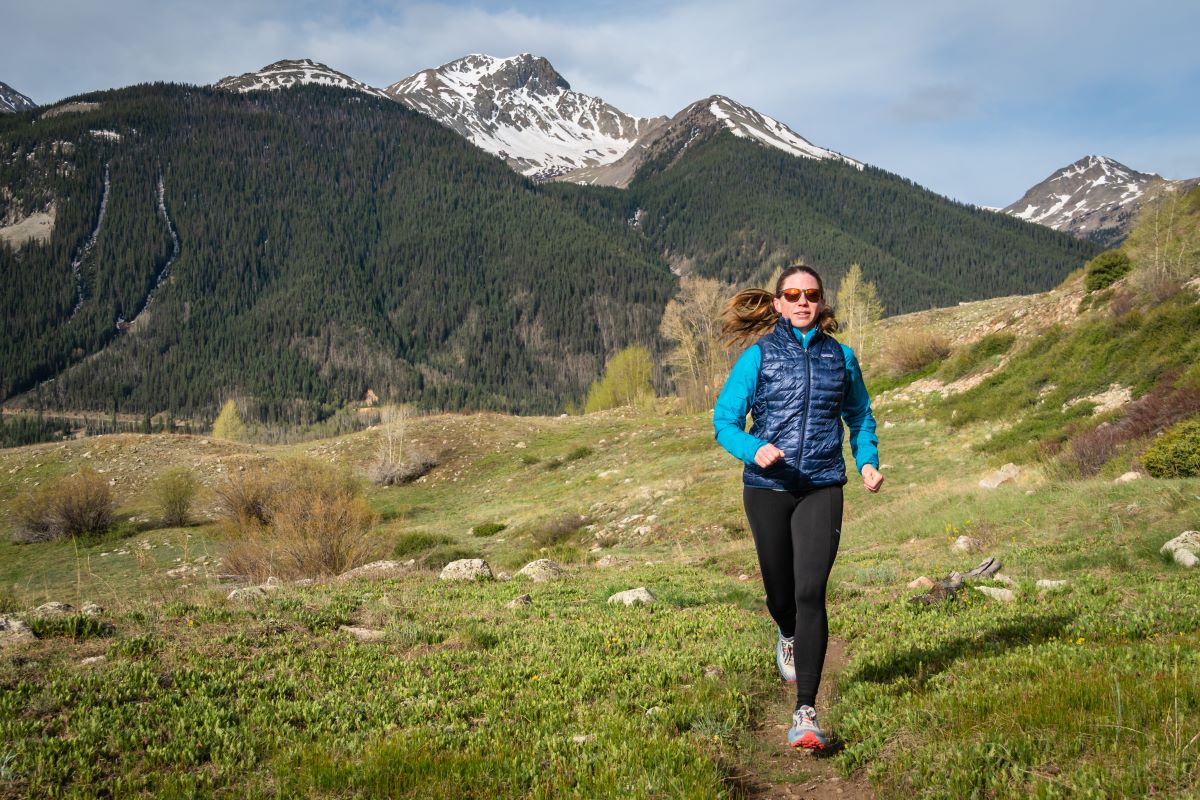
iRunFar’s Meghan Hicks tests the Brooks Caldera on a spring morning. This shoe is an excellent maximal trail running shoe. Photo: iRunFar/Eszter Horanyi
Buying Advice: How to Choose a Cushioned Trail Running Shoe
As with all other shoe types, finding the best cushioned trail running shoes for you will depend on your running style and the shape of your foot. There are several factors to consider when choosing between the carbon-plated Hoka Tecton X 3 and the mountain-ready La Sportiva Akasha II.
Stack Height
The stack height number will instantly indicate the amount of cushion to expect from a shoe. A cushioned shoe can have any number of millimeters of drop, but a stack height of 28 to 32 millimeters is average.
On the other hand, a shoe’s drop indicates how much midfoot and forefoot strike you will feel. A shoe can have a very high stack height and still be zero drop, though no shoes like this are included in this guide. More typical is the 33-millimeter stack height and five-millimeter drop of the Hoka Tecton X 3.
Roominess
With a primary goal of a cushioned shoe being comfort, nearly all of the shoes we selected as the best are very accommodating for swelling feet over long distances. Many less cushioned shoes require some sizing trickery to accommodate the foot and leg fatigue that is a part of ultrarunning. We commonly require sizing up in less cushioned shoes as runs get longer, but most of the shoes in this guide are perfect in the size you would traditionally wear, especially the wide forefooted Altra Olympus 6. Shoes with a narrow toebox, like the La Sportiva Akasha II, may become less comfortable over longer distances.
Lockdown
The added stack height in cushioned shoes can lead to stability issues on uneven surfaces, especially where lateral movement is required. One way to combat this is through lockdown with the upper. Lockdown is the way your midfoot and heel lock into the shoe through the heel and tongue construction and the lacing configuration. Cushioned shoes can be notoriously sloppy-feeling or loose, even giving your foot the feeling of sliding around; these are telltale signs that the shoe’s lockdown is poor. Our team found that the Brooks Caldera 8 had an excellent level of lockdown, especially for a cushioned trail running shoe.
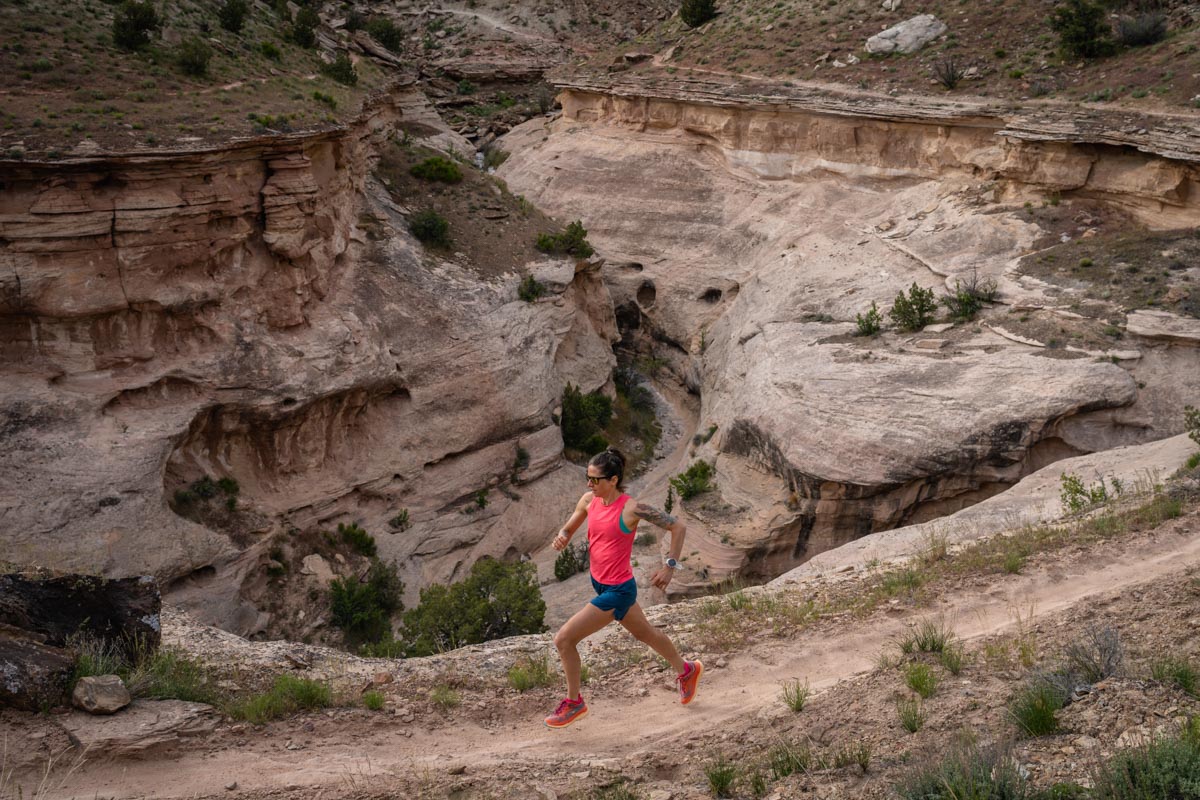
The earlier Hoka Tecton X 2 shoes provided exceptional propulsion on desert trails. Photo: iRunFar/Eszter Horanyi
Why You Should Trust Us
For the current iteration of this guide, iRunFar Founding Editor Bryon Powell, who has two decades of experience closely following the trail shoe world, consulted with ten members of the iRunFar test team for their favorite cushioned trail shoes. Our testers’ history with specific shoes includes the entire line in the cases of the Brooks Caldera and Hoka Speedgoat. At the same time, shoes that are newer to the cushioned category still have characteristics of other models from the brand that we could reference, like sizing consistency and durability. Our team tested the shoes throughout the year across the U.S. Rockies and Pacific Northwest.
Please note that product models are routinely discontinued in the running world, while new ones frequently come to market. At the same time, we here at iRunFar often keep using our top picks in our daily running … they’re our top picks, after all! Sometimes that continued use results in uncovering product failures. With all this — product discontinuations, product introductions, and product failures — in mind, we routinely update our buyer’s guides based on past and ongoing testing and research by our authors and editorial team. While these updates can appear to be us pushing the newest product, it’s anything but that. When we update any buyer’s guide, most products will likely remain the same. That matches our goal: to get you in the best gear you’ll use for a long time.
Frequently Asked Questions About Cushioned Trail Running Shoes
How much cushion is right?
In the past, this was a more serious question than today; back then, you might have sacrificed lockdown, stability, and weight for the plushness of a super-stacked shoe. Today, maximally cushioned shoes offer much better all-around performance than in the past, when these shoes were relegated to only smooth trails or away from any surface that might cause an ankle roll.
So how much cushion is right for you depends on your overall foot, ankle, and leg health — combined with factors like terrain, how much road you’re running to get to the trails, and budget. Many people will use a maximally cushioned shoe, like the Brooks Caldera 8 or Norda 005, for recovery runs, long runs, or as a way to reintroduce running after injury.
Do I need a highly cushioned shoe to race ultramarathons?
The short answer is no, but many runners, especially inexperienced ones, will appreciate the added comfort and cushion when facing longer-than-normal distances. Experienced racers will have a better feeling of whether they can sacrifice some comfort for less weight or acquire some comfort from a more aggressive, rockered shoe. The Hoka Speedgoat 6 strikes a nice balance between comfort and racing performance.
I don’t run high mileage. Should I still consider a cushioned shoe?
Yes. The notion that maximally cushioned shoes are only for people who run many miles or do ultramarathons frequently is misguided. Many of us will use a cushioned shoe like the Hoka Speedgoat 6 for all our running, be it long or short, thanks to the overall comfort and enjoyment the cushion provides.
I have a history of foot pain. Should I use cushioned shoes?
It really depends on your particular injury history, but for common ailments like tendinitis and sesamoid pain, you’ll want to really examine the stiffness or plushness of the shoe’s midsole and whether your particular pain would be relieved by one or the other. In general, because of the increased midsole stack and cushioning provided during each step, you can expect shoes such as the Brooks Caldera 8 to be beneficial for dealing with injuries.
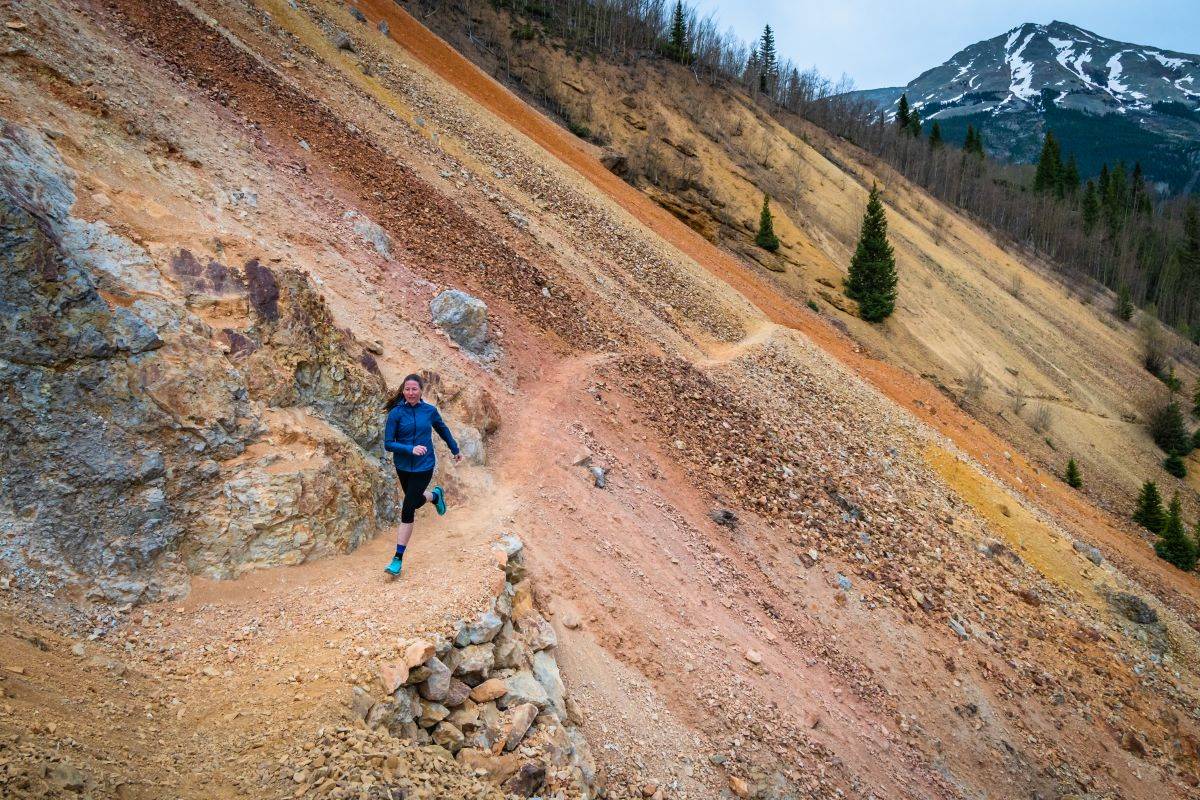
iRunFar’s Meghan Hicks plays on the trail in the now discontinued Scarpa Spin Infinity, which we previously named this a great cushioned trail shoe. Photo: iRunFar/Eszter Horanyi
I am wary of high-cushioned shoes, as I don’t want to feel like I’m on stilts on technical terrain. What can I do about this?
Look closely to find cushioned shoes with less stack height, a highly rated outsole like Vibram, and a firmer midsole. This combination of characteristics will give you more control, especially if paired with an upper with excellent lockdown. If you are a newer runner, it helps to experiment with different types of shoes to learn how lockdown and stack height affect your specific needs and habits as a runner. A shoe like the Hoka Tecton X 3 provides both cushion and high performance on technical terrain.
What is the difference between foam durometer and stack height with cushioned shoes?
The durometer measures the firmness of the foam under your foot. The stack height is the amount of foam between your foot and the ground. The Hoka Speedgoat 6 has the highest stack height in this guide, with a 40- and 35-millimeter stack for the heel and toe.
Do cushioned trail running shoes wear out faster than normal shoes?
While the foam in cushioned shoes can compress throughout a long run or ultra, it will rebound quickly and be ready to use again. Our testers have found that they can get up to 500 miles of use out of the La Sportiva Akasha II and Hoka Speedgoat 6 without noticing the significant compaction of the cushion. The outsoles and uppers of the best cushioned trail running shoes will last just as long as non-cushioned shoes.
Call for Comments
- Do you like more or less cushion in a trail running shoe?
- Do you have any favorite cushioned trail running shoes that we didn’t include in this guide?
- Have you tried any of the ones we did include, and what was your experience like?
